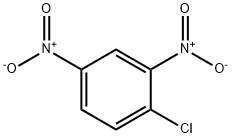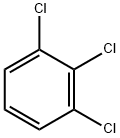T8164830
1-Chloro-2,4-dinitrobenzene , >99.0%(GC) , 97-00-7
Synonym(s):
1-Chloro-2,4-dinitrobenzene;2,4-Dinitrochlorobenzene;4-Chloro-1,3-dinitrobenzene, 1,3-Dinitro-4-chlorobenzene, 2,4-Dinitro-1-chlorobenzene;CDNB;DNCB
CAS NO.:97-00-7
Empirical Formula: C6H3ClN2O4
Molecular Weight: 202.55
MDL number: MFCD00007075
EINECS: 202-551-4
Update time: 2022-07-08
PRODUCT Properties
| Melting point: | 48-50 °C(lit.) |
| Boiling point: | 315 °C(lit.) |
| bulk density | 760kg/m3 |
| Density | 314 |
| vapor density | 6.98 (vs air) |
| vapor pressure | 1 hPa (106 °C) |
| refractive index | 1.5857 |
| Flash point: | 367 °F |
| storage temp. | Store below +30°C. |
| solubility | alcohol: very slightly soluble (cold)(lit.) |
| form | Crystalline Mass, Chunks or Crystals and Powder |
| color | Yellow to brown |
| Odor | Almond-like |
| explosive limit | 1.9-22%(V) |
| Water Solubility | insoluble |
| Merck | 14,2136 |
| BRN | 613161 |
| Stability: | Stable. Combustible. Incompatible with strong oxidizing agents, ammonia. Reacts violently with hydrazine hydrate. |
| LogP | 2.24 at 23.3℃ and pH3.5-5.5 |
| CAS DataBase Reference | 97-00-7(CAS DataBase Reference) |
| NIST Chemistry Reference | Benzene, 1-chloro-2,4-dinitro-(97-00-7) |
| EPA Substance Registry System | 2,4-Dinitrochlorobenzene (97-00-7) |
Description and Uses
1-Chloro-2,4-dinitrobenzene is used as a reagent for the detection and determination of pyridine compounds. It has been used as alkylating agent to evaluate the depletion of intracellular erythrocyte glutathione (GSH). It is an irreversible inhibitor of human thioredoxin reductase.
Safety
| Symbol(GHS) |     GHS05,GHS06,GHS08,GHS09 |
| Signal word | Danger |
| Hazard statements | H301+H331-H310-H315-H317-H318-H373-H410 |
| Precautionary statements | P262-P273-P280-P301+P310-P302+P352+P310-P305+P351+P338 |
| Hazard Codes | T,N |
| Risk Statements | 23/24/25-33-50/53-43-41-38 |
| Safety Statements | 28-36/37-45-60-61-28A-24 |
| RIDADR | UN 3441 6.1/PG 2 |
| WGK Germany | 2 |
| RTECS | CZ0525000 |
| Autoignition Temperature | 464 °C |
| Hazard Note | Toxic |
| TSCA | Yes |
| HS Code | 2904 99 00 |
| HazardClass | 6.1 |
| PackingGroup | II |
| Hazardous Substances Data | 97-00-7(Hazardous Substances Data) |
| Toxicity | LD50 orally in Rabbit: 640 mg/kg LD50 dermal Rabbit 130 mg/kg |



